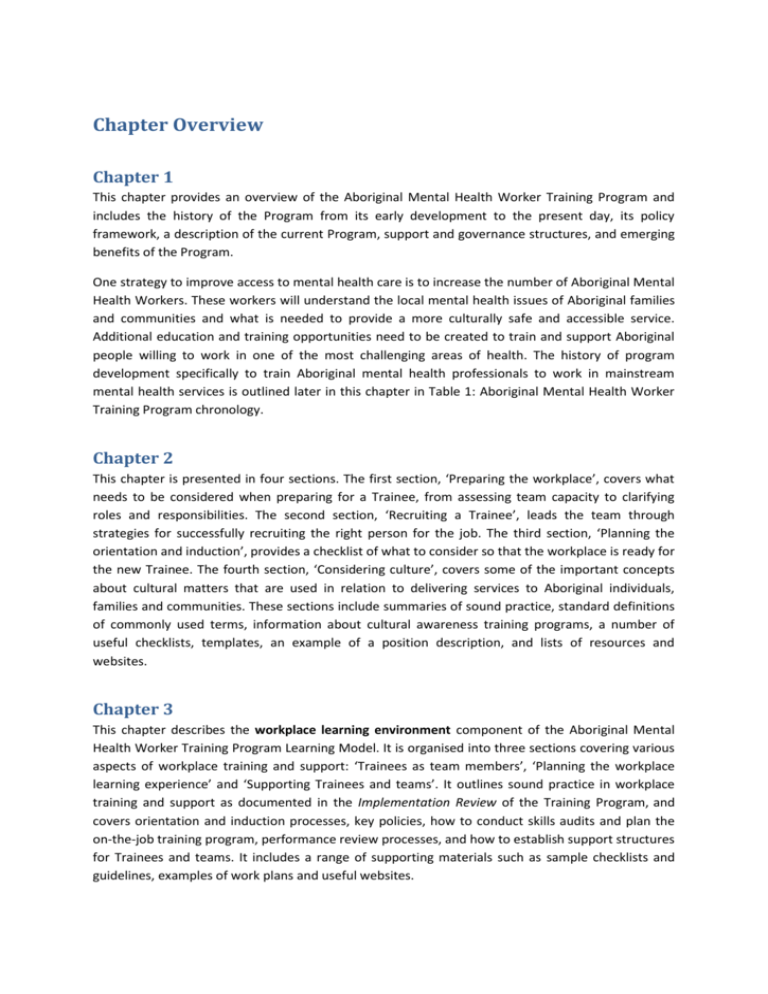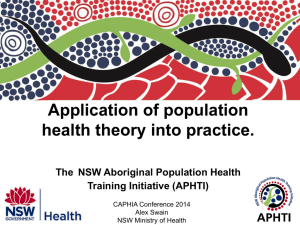Chapter Overview and Table of Contents
advertisement

Chapter Overview Chapter 1 This chapter provides an overview of the Aboriginal Mental Health Worker Training Program and includes the history of the Program from its early development to the present day, its policy framework, a description of the current Program, support and governance structures, and emerging benefits of the Program. One strategy to improve access to mental health care is to increase the number of Aboriginal Mental Health Workers. These workers will understand the local mental health issues of Aboriginal families and communities and what is needed to provide a more culturally safe and accessible service. Additional education and training opportunities need to be created to train and support Aboriginal people willing to work in one of the most challenging areas of health. The history of program development specifically to train Aboriginal mental health professionals to work in mainstream mental health services is outlined later in this chapter in Table 1: Aboriginal Mental Health Worker Training Program chronology. Chapter 2 This chapter is presented in four sections. The first section, ‘Preparing the workplace’, covers what needs to be considered when preparing for a Trainee, from assessing team capacity to clarifying roles and responsibilities. The second section, ‘Recruiting a Trainee’, leads the team through strategies for successfully recruiting the right person for the job. The third section, ‘Planning the orientation and induction’, provides a checklist of what to consider so that the workplace is ready for the new Trainee. The fourth section, ‘Considering culture’, covers some of the important concepts about cultural matters that are used in relation to delivering services to Aboriginal individuals, families and communities. These sections include summaries of sound practice, standard definitions of commonly used terms, information about cultural awareness training programs, a number of useful checklists, templates, an example of a position description, and lists of resources and websites. Chapter 3 This chapter describes the workplace learning environment component of the Aboriginal Mental Health Worker Training Program Learning Model. It is organised into three sections covering various aspects of workplace training and support: ‘Trainees as team members’, ‘Planning the workplace learning experience’ and ‘Supporting Trainees and teams’. It outlines sound practice in workplace training and support as documented in the Implementation Review of the Training Program, and covers orientation and induction processes, key policies, how to conduct skills audits and plan the on-the-job training program, performance review processes, and how to establish support structures for Trainees and teams. It includes a range of supporting materials such as sample checklists and guidelines, examples of work plans and useful websites. Chapter 4 This chapter describes the university learning environment component of the Aboriginal Mental Health Worker Training Program Learning Model. It includes a consideration of the Trainee as a student, a description of the Bachelor of Health Science (Mental Health), Djirruwang Program, offered by Charles Sturt University, the roles and responsibilities of university staff, and university study support and entitlements. Chapter 5 This chapter describes the placement learning environment component of the Aboriginal Mental Health Worker Training Program Learning Model. It includes information about the aim of clinical placements, an outline of requirements, expectations of the placement site, the responsibilities of Trainees as students in relation to organising placements and associated entitlements. Chapter 6 This chapter brings together in detail the three components of the Aboriginal Mental Health Worker Training Program Learning Model—the workplace learning environment, the university learning environment and the placement learning environment. It links workplace training with the CSU Bachelor of Health Science (Mental Health) course work and clinical placement requirements to demonstrate how the components can complement and reinforce each other over the three years of the Traineeship. Chapter 7 The Training Program is relatively new and is still developing. Careful monitoring and evaluation of the Program by the people most closely involved in it will help with its ongoing development at team, Area Health Service and State-wide levels. Monitoring activities and evaluating outcomes enable teams to reflect on what works and what does not and allows for continuous improvements to be made that will benefit teams, the Trainees, mental health services and the consumers. This chapter discusses the importance of monitoring and evaluation and describes the Program rationale and Program logic. The chapter outlines a monitoring and evaluation framework for the Training Program. Table of Contents Chapter 1: Overview of the Training Program Background—a brief history Description of the Training Program The Learning Model Governance and support Benefits of the Training Program Achievements of the Training Program Resources Chapter 2: Workplace Preparation and Recruitment Preparing the workplace Recruiting a Trainee Planning the orientation and induction Considering culture Supporting documents and resources Chapter 3: Workplace Training and Support Trainees as team members Planning the workplace learning experience Supporting Trainees and teams Glossary Supporting documents and resources Chapter 4: University Study and Support Trainee as a student University course: Bachelor of Health Science (Mental Health) Education provider: Roles and responsibilities University study support and entitlements Supporting documents Chapter 5: Clinical Placements and Support The placement component Planning and organising a clinical placement Djirruwang Program requirements Entitlements Supporting documents Chapter 6: Linking Work and Study Progressing from year one through year three Year One Year Two Year Three Transition from Trainee to graduate Continuing professional development Supporting document and resources Chapter 7: Monitoring and Evaluation Developing a monitoring and evaluation framework Aboriginal Mental Health Worker Training Program Logic Monitoring and evaluation plan Glossary Supporting documents Bibliography








